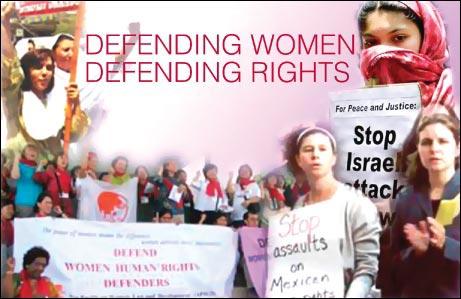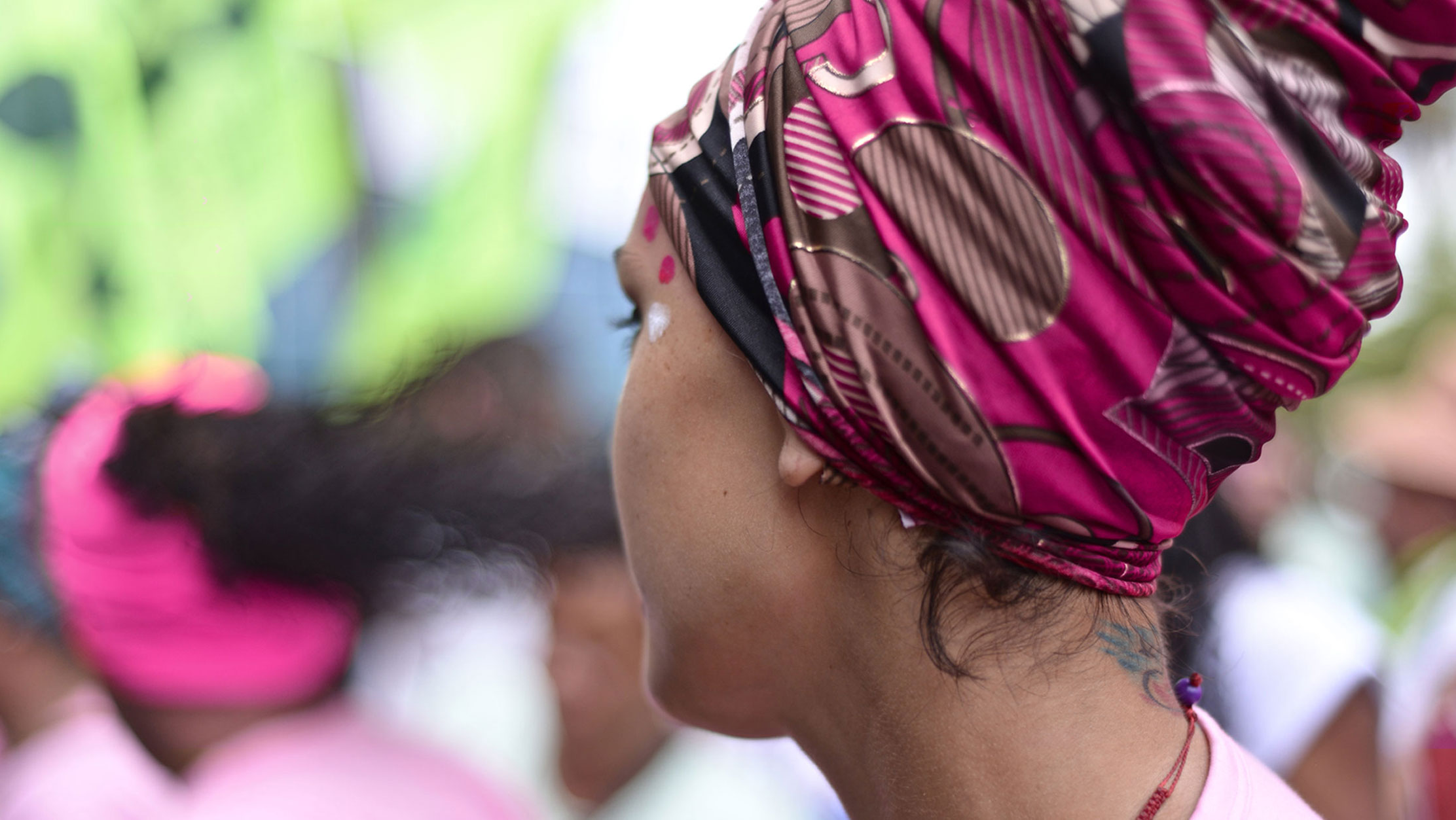FRIDAY FILE – On 27 November 2013 the United Nations General Assembly’s Third Committee adopted the first-ever resolution on women human rights defenders. But, this advance in protecting those who face risks and attacks for who they are and their work to promote women’s human rights came with strong opposition from conservative governments and consistent interference from the Holy See, which resulted in crucial language being compromised.
By Susan Tolmay and Marisa Viana
There has been growing awareness around the specific risks, discrimination and violations faced by human rights defenders and women human rights defenders (WHRDs) in particular – both at the hands of State and non-state actors. Such risks and discriminations are often justified on the basis of social norms, custom, religion or tradition. In 1999, the United Nations General Assembly (UN GA) adopted the UN Declaration on Human Rights Defenders, which states, “everyone has the right, individually and in association with others, to promote and to strive for the protection and realization of human rights and fundamental freedoms at the national and international levels.” In 2000, the UN Secretary General established the mandate for a Special Rapporteur on Human Rights Defenders to support the implementation of the Declaration on human rights defenders and also to gather information on the actual situation of human rights defenders around the world.
In 2011, Margaret Sekaggya, the Special Rapporteur on the situation of human rights defenders submitted her third report to the UN Human Rights Council, the first to focus exclusively on the situation of WHRDs and those working on women’s rights or gender issues, raising the necessity to address the specific and seriousness of the violations against them and the need for gender-specific protection. Sekaggya expressed concern about the extraordinary risks that WHRDs and those working on women’s rights or gender issues face due to their work, including arrests, mistreatment, torture, criminalization, wrongful sentencing, stigmatization, attacks, threats, death threats and killings, sexual violence and rape. She also reported that family members of WHRDs are also often targeted.

On November 27th, 2013, at the end of the United Nations General Assembly Third Committee, for the first time ever, a resolution on women human rights defenders entitled ‘Promotion of the Declaration on the Right and Responsibility of Individuals, Groups and Organs of Society to Promote and Protect Universally Recognized Human Rights and Fundamental Freedoms: Protecting Women Human Rights Defenders’ was adopted.
The resolution introduced by Norway, and co-sponsored by 35 countries recognises the specific risks, discrimination and violence women human rights defenders (WHRDs) face. This historical document urges States to put in place concrete gender-sensitive policies and programmes for the protection of women human rights defenders and to ensure their effective participation in the design and implementation of measures geared towards their protection. Furthermore, the resolution calls on States to ensure protection of women human rights defenders from intimidation or reprisals as result of cooperating with international institutions and unhindered access to and communications with regional and international human rights mechanisms.
Strong conservative opposition to women’s human rights
In March this year WHRDs were recognized for the first time ever, in the language of the Agreed Conclusions of the Commission on the Status of Women (CSW 57), specifically requiring States to “Support and protect those who are committed to eliminating violence against women, including women human rights defenders in this regard, who face particular risks of violence.”
As at CSW 57, negotiations at the UN GA’s Third Committee were heated and tense, with several states from Africa, Asia and the Middle East resisting acknowledging that violence against WHRDs is directly linked to their gender and the work they do to protect women’s rights including sexual and reproductive health and rights, and broad violations based on gender. This resistance was also heavily influenced by the Holy See’s very vocal presence as a permanent UN observer, which pushed for a clear definition of gender to mean men and women. Twelve written amendments from the African Group, China, Russia, Qatar, Kuwait, Iran, Iraq, Yemen, Saudi Arabia and Singapore were officially introduced attempting to weaken the resolution. The amendments included calling for the deletion of the definition paragraph, specifically the mention of gender equality, and the introduction of universally recognizedbefore human rights. Such qualifier to human rights would limit the scope of protection for WHRDs working on all human rights including sexual rights or issues related to sexual orientation and gender identity, which are not universally recognized.
There was early resistance to sexual and reproductive health and rights with the African Group, Asia and Middle East countries asserting that the paragraph referring to sexual and reproductive health and rights was out of context and irrelevant to discussions. Despite attempts by Norway, Panama and EU to retain the language and make further connections on its relevance to protecting WHRDs who experience heightened risks and violations due to their work on these issues, consensus on the paragraph was not reached and it was deleted from the final resolution. The failure to acknowledge the abuses, violence and heightened risks that WHRDs face in defending these rights is a clear failure to uphold rights that have been recognized for 18 years now, and which were reiterated in the Special Rapporteur on the situation of human rights defenders’ 2010 report, where she underscored “(M)andate holders have reiterated on several occasions that women defenders are more at risk of suffering certain forms of violence and other violations, prejudice, exclusion, and repudiation than their male counterparts. This is often due to the fact that women defenders are perceived as challenging accepted socio-cultural norms, traditions, perceptions and stereotypes about femininity and the role and status of women in society.”[i]
After tough negotiations and strong opposition to the proposed resolution until the last minute, consensus amongst States was reached at the expense of a crucial paragraph containing language calling on States to condemn all forms of violence against women and WHRDs and to refrain from invoking any customs, tradition or religious consideration to avoid obligations with respect to the elimination of violence against women. Such language has previously been agreed to by the General Assembly in Resolution 67/144 on the Intensification of Efforts to Eliminate All Forms of Violence Against Women. States who opposed the draft resolution and introduced the written amendments, asked for the deletion of this important paragraph in exchange for the withdrawal of their amendments. This concession, however, resulted in members of the European Union withdrawing their co-sponsorship of the Resolution.
An important step forward
Despite the challenges, however, the resolution is still an important step forward in providing concrete recommendations on specific remedies States must take to enable the work of WHRDs and those defending women’s human rights, so that they can carry out their work in safety, free from intimidation, violence and attacks.
Of note, is the important step towards a common definition of WHRDs stated as ‘women of all ages who engage in the promotion and protection of all human rights and fundamental freedoms and all people who engage in the defence of the rights of women and gender equality, individually and in association with others.’ While this definition is limited to gender equality as opposed to more broadly referring to gender issues and matters related to sexuality, it provides a common recognition for all women working on defending human rights and all people who defend women’s human rights and rights related to gender.
Importantly, the Resolution calls on States to bring perpetrators of abuses to justice, including gender-based violence, violations and discrimination against WHRDs – including violence and threats committed by State and non-state actors. The Resolution highlights that “impunity for violations and abuses against women human rights defenders persists owing to factors including a lack of reporting, documentation, investigation and access to justice, social barriers and constraints with regard to addressing gender-based violence, including sexual violence and the stigmatization that may result from such violations and abuses, and a lack of recognition of the legitimate role of women human rights defenders, all of which entrench or institutionalize gender discrimination.”
WHRDs suffer systematic violations and abuses of their human rights and historical and structural inequalities in power relations and discrimination against women have direct impact on how women, including WHRDs, are treated and perceived. To this end, the resolution calls on States to take appropriate measures for the realization of gender-equality and elimination of gender stereotypes, harmful attitudes and practices that serve to condone violence and discrimination against women, including WHRDs.
During the lengthy negotiations, civil society organizations from around the world exerted pressure on States to fulfil their commitment to WHRDs by mobilizing at the national and international levels, as well as through social media. A letter by civil society groups in Africa reached African States capital and UN missions asking for support for the resolution. Women Nobel Peace Prize winners and members of the Elders sent letters calling on governments to support the protection of WHRDs by supporting a strong resolution. And in the last crucial week of negotiations, individuals and organizations from around the world were active through Twitter, demanding the resolution be passed without compromising human rights. This wave of support for a resolution that calls for the concrete measures for the protection of WHRDs is testament to the importance of their work around the world and a message to States and government representatives that they must fulfill their roles in protecting, promoting and fulfilling human rights.
It will now be important to work towards ensuring that States do not regress on commitments made at the international level and quickly take steps towards full implementation of this important resolution.
[i] (A/HRC/16/44, para.23)
